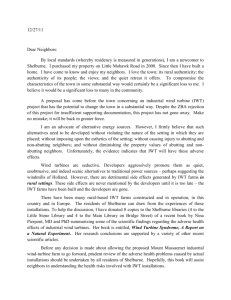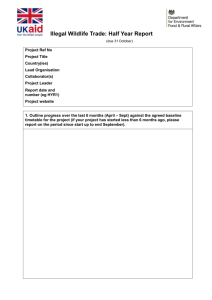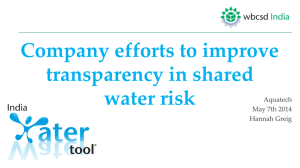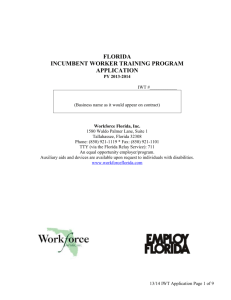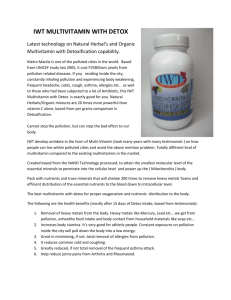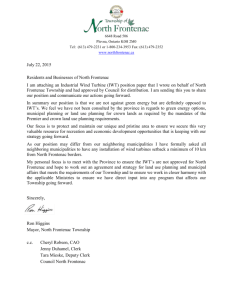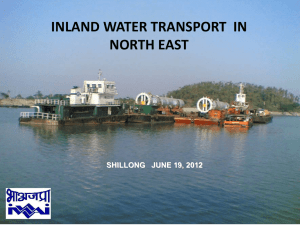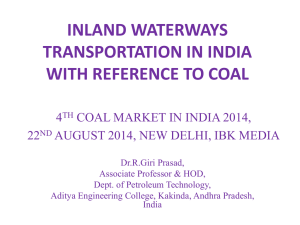Redevelopment of inland water transport for post-conflict
advertisement
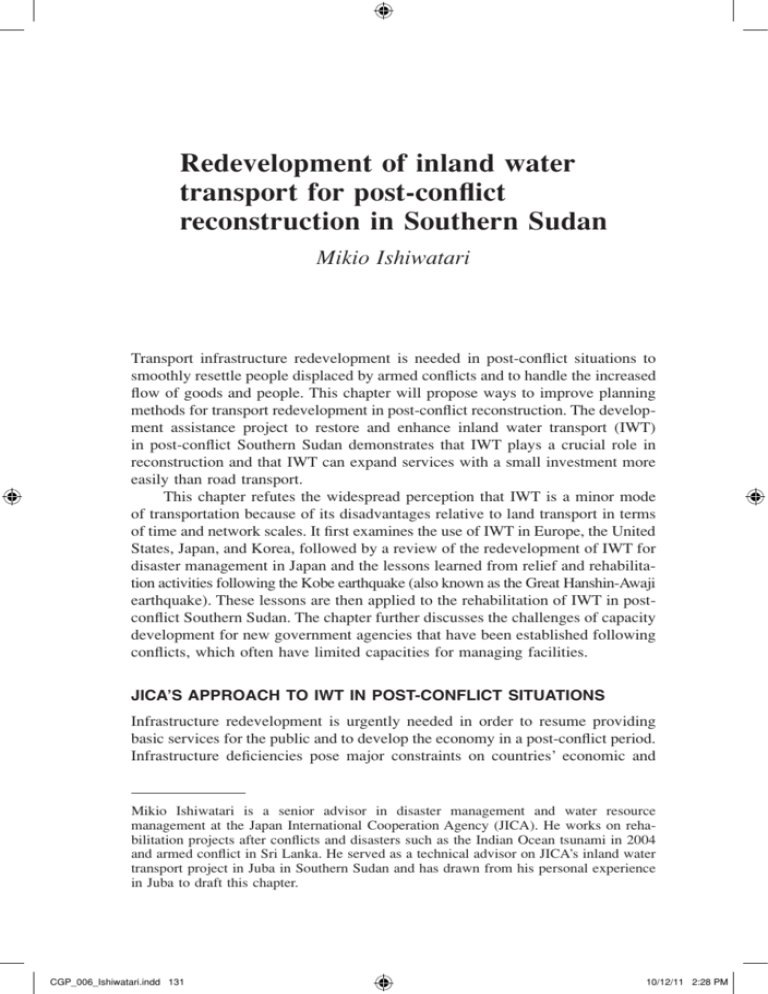
Redevelopment of inland water transport for post-conflict reconstruction in Southern Sudan Mikio Ishiwatari Transport infrastructure redevelopment is needed in post-conflict situations to smoothly resettle people displaced by armed conflicts and to handle the increased flow of goods and people. This chapter will propose ways to improve planning methods for transport redevelopment in post-conflict reconstruction. The development assistance project to restore and enhance inland water transport (IWT) in post-conflict Southern Sudan demonstrates that IWT plays a crucial role in reconstruction and that IWT can expand services with a small investment more easily than road transport. This chapter refutes the widespread perception that IWT is a minor mode of transportation because of its disadvantages relative to land transport in terms of time and network scales. It first examines the use of IWT in Europe, the United States, Japan, and Korea, followed by a review of the redevelopment of IWT for disaster management in Japan and the lessons learned from relief and rehabilitation activities following the Kobe earthquake (also known as the Great Hanshin-Awaji earthquake). These lessons are then applied to the rehabilitation of IWT in postconflict Southern Sudan. The chapter further discusses the challenges of capacity development for new government agencies that have been established following conflicts, which often have limited capacities for managing facilities. JICA’S APPROACH TO IWT IN POST-CONFLICT situations Infrastructure redevelopment is urgently needed in order to resume providing basic services for the public and to develop the economy in a post-conflict period. Infrastructure deficiencies pose major constraints on countries’ economic and Mikio Ishiwatari is a senior advisor in disaster management and water resource management at the Japan International Cooperation Agency (JICA). He works on rehabilitation projects after conflicts and disasters such as the Indian Ocean tsunami in 2004 and armed conflict in Sri Lanka. He served as a technical advisor on JICA’s inland water transport project in Juba in Southern Sudan and has drawn from his personal experience in Juba to draft this chapter. CGP_006_Ishiwatari.indd 131 10/12/11 2:28 PM 132 Harnessing natural resources for peacebuilding social development (JICA 2006). Transport infrastructure must be redeveloped to handle people displaced by conflicts and the increased flows of goods and people. Once a conflict ends, road rehabilitation is placed at a higher priority on a transport project list than water transportation. Road rehabilitation work, however, requires enormous investments and long periods of time. Also, transport on rehabilitated roads may be easily disrupted by security threats such as landmines buried during the conflict. Where a body of water is navigable, water transport has the potential to contribute to reconstruction immediately after the conflict. Even if construction work is required, port rehabilitation, as a single location investment, can be arranged more easily than an investment in a road network. IWT, however, is not recognized as a major mode of transport in post-conflict situations. This is because IWT is a neglected mode of transportation, even during peacetime (Hilling 1996). Transport is synonymous with roads for development agencies, policy makers, and planners (Booth, Hanmer, and Lovell 2000). IWT, the reach of which is limited by nature, is usually considered old-fashioned and outdated (UNESCAP 2006). For example, the sector approach applied to transport by the Japan Inter­ national Cooperation Agency (JICA) does not cover IWT at all (JICA 2007a)1. IWT is rarely selected as an alternative mode in JICA’s transport projects, because the agency has a limited number of IWT specialists and limited experience in IWT. Since the Cold War structures collapsed, armed conflicts have occurred, in particular, in developing countries. These conflicts destroy the achievements of development and waste financial resources and energy that can be used for development. Moreover, they make it extremely difficult for people to maintain their lives, livelihoods, and dignity. Peace and stability are prerequisites for development (GOJ 2005). Development assistance, however, has rarely dealt with conflicts. By nature, development assistance addresses long-term problems of poverty, economy, and social inequities (Ogata 2007). Between 1991 and 2002, approximately 5 percent of official development assistance (ODA) from industrialized countries was allocated to emergency relief, mainly for humanitarian crises arising out of conflicts (Anand 2005). Since Sadako Ogata began her term as president of JICA in 2003, JICA has carried out various peacebuilding support activities. The agency has supported countries that need post-conflict reconstruction, such as Cambodia, Afghanistan, Bosnia and Herzegovina, and Timor-Leste. The new ODA charter adopted at a Japanese Cabinet meeting in 2003 defines peacebuilding as a priority issue of Japan’s ODA (GOJ 2003). JICA announced a reform plan in 2004 that stresses strengthening support for peacebuilding (JICA 2004). JICA has promoted human development and 1 JICA is the world’s largest bilateral development assistance agency with a budget of approximately US$10 billion and provides technical assistance, concessionary official development assistance loans, and grant aid to developing countries. CGP_006_Ishiwatari.indd 132 10/12/11 2:28 PM Inland water transport in Southern Sudan 133 Notes: A – The Hala’ib Triangle, claimed by Sudan and de facto administered by Egypt. B – The Hemi Triangle, claimed by Ethiopia, Sudan, and Kenya and de facto controlled by Kenya. security measures in peacebuilding by formulating guidelines for peacebuilding and establishing a new Office of Peace Building (JICA 2004). As a development assistance organization, JICA utilizes medium and long-term perspectives, as well as its knowledge of human and capacity development. JICA, however, has not accumulated enough experience and knowledge of development assistance projects in post-conflict reconstruction, because of its limited period of involvement in peacebuilding. Development assistance methods for post-conflict projects should be improved based on experience and knowledge gained through domestic projects in Japan. This chapter reviews recent projects to develop IWT in disaster management in Japan after the Great Hanshin-Awaji earthquake in Kobe, Japan, in 1995. The chapter demonstrates the key role IWT plays in post-conflict reconstruction CGP_006_Ishiwatari.indd 133 10/12/11 2:28 PM 134 Harnessing natural resources for peacebuilding through the examination of post-conflict Southern Sudan, where JICA has supported rehabilitation and development of IWT. The chapter further discusses the necessity of capacity development in addition to infrastructure redevelopment. IWT IN POST-CONFLICT AND DISASTER MANAGEMENT IWT has been developed by examining the geographic and socioeconomic background of each particular region and has contributed to society in a broad range of ways. This section reviews studies of infrastructure redevelopment in postconflict periods and the utilization of IWT in major countries. It also examines the lessons learned from the Kobe earthquake in 1995 and the redevelopment of IWT in Japan. Since the earthquake, IWT has gained recognition as an effective form of transportation in disaster relief and rehabilitation. Methods of infrastructure redevelopment in post-conflict situations Few studies argue the merits of infrastructure redevelopment in a post-conflict period. While recent studies analyze how infrastructure redevelopment is approached in general, most studies have not focused on specific projects, such as IWT and capacity development. The redevelopment of infrastructure contributes to governing a nation in post-conflict countries by reducing the security gap, capacity gap, and legitimacy gap (Yoshida and Yamamoto 2007). Infrastructure reconstruction is an opportun­ ity to rebuild various local institutions, which are crucial to sustaining peace (Anand 2005). Infrastructure redevelopment requires more careful planning and arrangement than ordinary development projects and has to be coupled with good policies (Hoeffler 1999). International funding may be sudden and substantial, but by overloading government capacity in the initial post-conflict period, such aid can easily lead to waste or open the way for corruption (MacDonald 2005). Physical infrastructure rehabilitation alone cannot resolve the issues of post-conflict reconstruction. Capacities for infrastructure management should be developed in parallel. Government organizations usually lack adequate public revenue and the capacity to develop and manage infrastructure. They have weakened institutions and limited human resources. Setting up administrative, accounting, financial management, fiduciary, and procurement systems takes time, especially in post-conflict countries (Schwartz, Hahn, and Bannon 2004). IWT as a neglected mode of transport IWT, which is a low-cost, energy-efficient, and environmentally friendly mode of transport, represents an ideal infrastructure in sustainable development. Its energy consumption per kilometer/ton of transported goods is approximately 17 percent of that of road transport and 50 percent of rail transport. Since the CGP_006_Ishiwatari.indd 134 10/12/11 2:28 PM Inland water transport in Southern Sudan 135 carbon emissions from IWT are much lower than those of road freight transport, IWT can contribute to promoting a low-carbon society. The external costs (climate change, noise, accidents, and emissions) associated with IWT are the lowest of the major modes of transport. The overall costs of all externalities for bulk transports using IWT are roughly 83 percent lower than road and roughly 70 percent lower than rail transport. In container transport, IWT costs 78 percent less than road transport and 68 percent less than rail transport (PLANCO Consulting GmbH 2007). IWT can serve as a convenient mode of transport in congested cities as well, such as Bangkok and Manila. IWT is closely associated with tourism, recreation, and community development. Since IWT ensures a high degree of safety, it is a suitable mode for transporting dangerous goods. IWT, however, has been neglected as a mode of transport and does not usually feature prominently in the transport planning strategies of most countries. Only 10 percent of the capacity of large rivers in Europe, such as the Danube, the Seine, or the Rhône, have been developed. The modal share of IWT in the European Union does not exceed 6 percent. In the United States it reaches up to 12 percent of overall freight shipments. Long lengths of navigable waters remain undeveloped. Experts in IWT discussed these issues at sessions of the Water and Transport Theme at the Third World Water Forum in Kyoto in 2003, and they identified the following reasons for this underdevelopment (Water and Transport 2003): • Poor recognition of the potential contribution of IWT to resolve a wide range of economic, environmental, and social issues. • General lack of basic infrastructure, technology, and financial resources. • Failure to integrate IWT within a comprehensive transport system. • Failure to include IWT within integrated water resource management. • Insufficient institutional capacity, legal instruments, and policies. • Inadequate public awareness and little political will for promotion. IWT in Europe Where waterways are available, IWT represents a significant share of the overall transportation of goods in Europe: 42 percent in the Netherlands, 12 percent in Belgium, and 14 percent in Germany. IWT is the largest carrier of building materials in Europe, accounting for 39 percent of building materials transported, and it is an important carrier of cereals, agricultural products, solid fuels, and ores. Roughly 80 percent of all transported hazardous goods such as solid fuels, petroleum products, and basic chemicals are shipped by IWT (Inland Navigation Europe n.d.). The European Commission aims to promote and strengthen the competitive position of IWT in the total transport system in Europe including land, air, and sea. The commission also seeks to facilitate the integration of IWT into the intermodal logistic chain. In 2006, on the recognition of IWT’s advantages, the European Commission issued the first comprehensive development program for CGP_006_Ishiwatari.indd 135 10/12/11 2:28 PM 136 Harnessing natural resources for peacebuilding IWT, the Navigation and Inland Waterway Action and Development in Europe (NAIADES). IWT will contribute to relieving traffic congestion and to mastering energy use and sustainable distribution solutions by linking navigable waterways to the road, rail, and short-sea networks. The NAIADES Action Programme (2006–2013), as outlined by the Commission of the European Communities (2006), focuses on the following five strategic areas: 1. 2. 3. 4. 5. Creating a sound business climate and attracting new markets. Stimulating fleet modernization and innovation. Attracting a new workforce and increasing investment in human capital. Promoting IWT. Providing an adequate IWT infrastructure. IWT in the United States The U.S. Army Corps of Engineers operates and maintains nearly 19,000 kilometers of waterways with more than 200 locks and dams. IWT accounts for roughly 15 percent of the total intercity commerce by volume. More than 50 percent of U.S. grain exports depend on the river network. Principal commodity groups transported using IWT include coal, petroleum, farm products, chemicals, and crude materials such as aggregates for construction and other minerals (Grier 2002). IWT infrastructure may also be used in disaster management. IWT was utilized for response activities in the aftermath of the September 11, 2001, attack on the World Trade Center. According to the New York Port Authority, 160,000 people were evacuated from New York City on New York Waterway ferries, and 250,000 to 300,000 left by other water transportation, which included Coast Guard vessels and other privately operated dining boats, and even tug-boats. A retired fireboat evacuated 150 people on September 11 and came back to pump water to the World Trade Center site (DeBlasio et al. 2002). Vessels evacuated over 2,000 injured people to Jersey City, where a triage center and ambulances were deployed. Seventy barges worked to remove 10,000 tons of debris a day, and a total of 1.62 million tons of debris were hauled over ten months (Pietrowsky 2003). IWT in Japan As in other countries, IWT had been utilized as a major mode of transport throughout the history of Japan. Different forms of energy, such as wind, human, and water were used to navigate IWT. From the seventeenth century until the nineteenth century, IWT supported socioeconomic activities in the city of Edo, now Tokyo, and during the Edo era it was the most populous city in the world. At the beginning of Japanese modernization in the late nineteenth century, the Japanese government developed river channels to utilize IWT as a modernized CGP_006_Ishiwatari.indd 136 10/12/11 2:28 PM Inland water transport in Southern Sudan 137 Figure 1. Number of ships on rivers in Japan Source: Goto (2008). Note: Data unavailable for 1913. mode of transport. IWT, however, started to decline around the beginning of the twentieth century when the government was shifting investment to land transport systems of railways and roads (Matsuda 1993a). Figure 1 shows the declining trend of ship numbers in Japanese rivers before the Second World War (Goto 2008). The Tone Canal, which is an important route connecting the Tokyo metropolitan area and northern Japan, experienced a decline in the volume of ship traffic during the same period (see figure 2). Currently, the share of IWT in rivers is kept at a minimum level in the transport sector. In 1996, only 4.7 million passengers and 2.7 million tons of cargo were carried by IWT in major rivers (Riverfront Development Center 2003). While IWT in rivers declined, coastal shipping increased in accordance with Japan’s rapid economic development after the Second World War. In the 1970s, coastal shipping carried about half the domestic freight transport volume in terms of tons per kilometer (Matsuda 1993b). Japan’s Ministry of Land, Infrastructure, Transport, and Tourism is respons­ ible for supporting IWT by securing navigation routes and developing facilities. The ministry established a committee in 1997 to explore the promotion of IWT. The committee recommended that the ministry take the following steps: 1. Secure navigable IWT routes. 2. Construct facilities, such as jetties and berths, and revive Kashi, a historical river port and market area. 3. Incorporate IWT into the holistic transport network. CGP_006_Ishiwatari.indd 137 10/12/11 2:28 PM 138 Harnessing natural resources for peacebuilding Figure 2. Traffic volumes in Tone Canal, Japan Source: Riverfront Development Center (2003). 4. Standardize regulations on river use and secure navigational safety by estab­ lishing navigation rules. 5. Develop technology to mitigate the environmental impacts of vessel navigation (Ministry of Construction 1997). The ministry is promoting a policy of modal shift from roads to railways and ships to reduce carbon dioxide emissions. The promotion of IWT contributes to this policy. IWT in Korea The Korean government is constructing the nineteen kilometer Gyeong-In Waterway, which connects the West Sea and Haengju Bridge. This project, worth US$1.6 billion, aims to control floods in the Gulpo River Basin and to improve logistical systems around three areas: the Seoul metropolitan area, Incheon City, and Gyung-Ki Province. In flood seasons, the waterway will function as a storage dam linked with the main Gulpo River, while in normal seasons, the waterway will be utilized as a navigational channel to transport industrial products to Seoul and offer amenities such as tourist attractions and water activities (Kim, Lim, and Park 2009). The project is scheduled for completion in 2011. CGP_006_Ishiwatari.indd 138 10/12/11 2:28 PM Inland water transport in Southern Sudan 139 IWT development in disaster rehabilitation following the Kobe earthquake in Japan IWT gained recognition as an effective form of transportation in disaster relief and rehabilitation following the Kobe earthquake in 1995. Water transport was extensively utilized for various purposes in Kobe, where major roads and all railway networks were destroyed. The water transport of rescue workers, relief goods, and emergency patients started immediately after the earthquake by utilizing natural banks and damaged facilities. Within four months, over 600,000 people were transported by ship instead of the land networks of destroyed railways and congested roads (Kaihara 2003). Around 33,000 tons of relief goods were also transported by ship (Inoue 1996). Six million tons of debris from collapsed buildings and facilities were transported away from Kobe, and 1.5 million tons of debris were transported away from other cities. The authorities rehabilitated damaged port facilities more quickly than roads and railways. Some 80 percent of quays were damaged, and only nine among 239 berths were available in the Kobe port. After two weeks, over one third of berths were rehabilitated and operational. Shinkansen (a bullet train connecting major cities in the country), the subways, and the railways of thirteen companies were damaged, including all three lines between Kobe and Osaka. It took over one month to resume railway operation between Kobe and Osaka. Even after three months, it took commuters over one hour to get from Kobe to Osaka, around two times the amount of time it took before the earthquake (Kobayashi 2005). Thirty-six sections of twenty-seven road routes including highways were closed. Traffic was heavily congested at major passable routes. The Japanese government learned from the Kobe earthquake and recognized the need to develop IWT facilities and capacities (Ikeda 1996). The Japanese government is constructing jetties to transport isolated commuters, equipment, materials, foods, and medicines for relief and rehabilitation activities in the event of a major earthquake in the Tokyo metropolitan area. In the Kansai area including the prefectures of Osaka and Kyoto, the government is constructing jetties in the Yodogawa River. During normal times, these facilities are utilized for sightseeing ships in Osaka, a city that in ancient times was known as the “Water City.” Since IWT is currently a minor mode of transport in Japan, its management systems are not well established. As such, it is crucial for Japan to develop its capacity to operate and maintain IWT so that it may properly utilize IWT during emergencies. Japan’s national government is conducting emergency drills in collaboration with local governments and civil society groups to strengthen IWT networks (MLIT 2006). Concerned agencies and private sector companies are also conducting drills to improve the operation of ships transferring people and relief goods in the case of an earthquake. CGP_006_Ishiwatari.indd 139 10/12/11 2:28 PM 140 Harnessing natural resources for peacebuilding A crucial issue was found in operating IWT: all the facilities that were constructed are not utilized during normal times in the Tokyo metropolitan area. In addition to constructing facilities, in order to function properly, systems must also be developed to operate and maintain said facilities. The gates of the jetties are locked despite the fact that the public could utilize them for pleasure and tourism. The jetties constructed in the Tokyo metropolitan areas should be utilized at normal times in order to be utilized effectively during emergencies (Miura, Jinnai, and Yoshikawa 2008). Without accessing the facilities, people cannot recognize the presence and usefulness of IWT for disaster management. This is, therefore, an important lesson—capacity development in operating facilities is crucial to utilizing IWT during emergencies. The domestic usefulness of IWT during emergencies and the importance of capacity development can serve as useful lessons to Japanese ODA projects in post-conflict reconstruction elsewhere. However, these lessons were not properly reflected in ODA projects because of a lack of feedback systems that effectively integrated the knowledge and practices of domestic activities and the Japanese ODA. IWT REDEVELOPMENT IN SOUTHERN SUDAN As an exceptional case under Japanese ODA, JICA has supported IWT redevelopment as a major mode of transport in Southern Sudan. Even during armed conflicts, IWT was actively utilized in the White Nile River. When the conflicts ended, JICA staff recognized the need to redevelop IWT. Conflict in Sudan With some 2.5 million square kilometers, Sudan is the largest country in Africa, rich in natural resources and with an estimated population of 39.2 million in 2008 (see figure 3). The 2007 Human Development Index ranked Sudan at 150th (UNDP 2009). Conflicts in Sudan between the mainly Islamic dominated northern government in Khartoum and the Christian animist south began shortly before independence from Britain in 1955. This continued, with sporadic outbreaks of peace, until the Comprehensive Peace Agreement was signed between the central government in Khartoum and southern rebels in 2005. It was one of Africa’s most deadly armed conflicts, with an estimated 2 million casualties and 4 million displaced persons. Although the conflict in Sudan has been commonly attributed to historical, religious, or racial enmity, resource scarcity is in fact the cause. Drought and desertification have increased pressure on water and land resources, forcing group migration into areas historically settled by others (Fukuda-Parr et al. 2008). With the exception of a few areas such as the Darfur region, the peace agreement ended the conflict and created two governments in one country: the national government and the government of Southern Sudan. Southern Sudan was granted a high level of independence within Sudan until 2011, when a popular CGP_006_Ishiwatari.indd 140 10/12/11 2:28 PM Inland water transport in Southern Sudan 141 * Democratic Republic of the Congo. Figure 3. Nile River and Juba Port Sources: Adapted from unpublished JICA internal documents. referendum called for the South to secede. On the basis of the Comprehensive Peace Agreement’s power sharing and security arrangements, until 2011 the dominant political force in the South was the former rebel movement (consisting of the Sudan People’s Liberation Movement and the Sudan People’s Liberation Army), and the ruling party in Khartoum (the National Congress Party) was the junior partner (Unger and Wils 2007). The agreement stipulated the principle of equal revenue sharing of oil between the South and the North. South Sudan’s relevant statistics are as follows (The Republic of South Sudan National Bureau of Statistics 2011a, 2011b). 1. Area: 644,329 square kilometers consisting of ten states. 2. Population: 8.26 million. 3. Gross domestic product: US$1,546 in 2010. The Nile is the longest river in the world, and 60 percent of its 6,671 kilometers lie within Sudan. The Blue Nile and White Nile join in Khartoum and form the Nile River that flows to Egypt. The longest navigable route is the White Nile, which stretches 1,436 kilometers to connect Juba in the south to Kosti in the north (Abebe 2003). Transport infrastructures in the country are not well developed or maintained. The paved road network is mainly limited to the northern and eastern parts of the country. The total paved highway is about 3,599 kilometers. The country has about 4,789 kilometers of narrow gauge railways, mostly in the north and east. Some 40 percent of the total rail network is out of service now (Abebe 2003). CGP_006_Ishiwatari.indd 141 10/12/11 2:28 PM 142 Harnessing natural resources for peacebuilding Transport sector in Juba Juba is situated in Juba County in the Central Equatorial State, formerly Bahr al Jebel State in Southern Sudan. The city, which was a fortress town controlled by the government of Sudan during the conflict, became the capital of Southern Sudan in 2005. The population of the city was estimated at around 250,000 in 2005 and is rapidly increasing because of returning internally displaced persons (IDPs) and people migrating in from rural areas. JICA conducted field surveys and estimated the current population to be roughly 400,000 in 2009 (JICA 2009), which constitutes a 60 percent increase over the last four years. Government agencies did not provide public urban services during the conflict. No urban infrastructure, such as administrative buildings, roads, water supply, solid waste management, electricity, and communications networks, were developed or maintained in the past thirty years (Ishiwatari 2009). Most urban facilities were deteriorated and required rehabilitation or construction. There were only two kilometers of paved road inside the city when the peace agreement was signed in 2005. Even after an emergency project to rehabilitate the water supply, only 8 percent of the population had access to safe water in 2009. JICA started development assistance projects in 2006 to urgently develop and expand basic social and economic services. These services are needed to promote the settlement of returning IDPs in their communities. JICA conducted projects for: (i) the formulation of Juba urban planning by 2015; (ii) the redevelopment of water supply facilities; and (iii) vocational training on basic construction and manufacture skills. Juba is the southern terminus of commercial traffic along the Nile River, which runs through the eastern side of the city. Five regional arterial roads connect the city with neighboring regions and countries. During the conflict, the city was often surrounded and totally isolated from the outside, and most transport infrastructures were destroyed. After the conflict, water, air, and road transport modes occupied 61 percent, 23 percent, and 16 percent, respectively, of goods transport in 2005 (JICA 2007b). Transportation of goods to and from other cities in the north mainly depends on IWT on the White Nile River, because there is no reliable passable road (see table 1). IWT is used for emergency and rehabilitation operations in post-conflict situations. The United Nations World Food Programme relies largely upon IWT to transport emergency food to Juba. Since the peace agreement, IDPs who were evacuated to other areas in Sudan during the conflict are returning to Juba by IWT. Transport to and from the south mainly depends on land transport. The city is narrowly linked with Uganda, Democratic Republic of the Congo, and Kenya by roads, which are gravel-surfaced and in poor condition. The World Food Programme has been implementing emergency road repair programs to upgrade the roads to at least basic international road transport conditions. Air transportation is used for valuable goods and urgent transport, such as medicine, CGP_006_Ishiwatari.indd 142 10/12/11 2:28 PM Inland water transport in Southern Sudan 143 Table 1. Road traffic situation from Juba as of 2007 Direction Situation Traffic situation To Uganda To Kenya To Democratic Republic of the Congo To the northern area in South Sudan To Khartoum Repair is not yet completed Armed groups’ threats Repair works were completed Almost impassible Very little traffic volume Only available international road Impassable Not yet repaired. Impassible bridges and buried landmines Not yet repaired. Security issues and buried landmines Impassable Source: Adapted from JICA (2007b). Table 2. Fee and duration of various modes of transportation from Juba Mode Fee (US$/ton) Average duration from Kosti (days) Water Road Air 400 475 2,500 20 10 not available Source: Developed by author based on JICA (2008). food transport mainly from Kenya, and the transportation of construction mater­ ials and equipment by construction companies abroad. IWT is the cheapest among the three modes of transportation, cheaper than road by about 20 percent, and roughly one-sixth of the price of air transportation. As for the amount of time required to carry the goods from the north, IWT takes the longest time, double that of transportation by road. Table 2 shows transport fees per ton and average duration to Juba from Kosti, which is the main port on the River Nile in North Sudan. The volume of goods transported by IWT is increasing because of rapid economic development under post-conflict reconstruction. Based on interview surveys of IWT operators, average monthly transport volumes were estimated at 530 passengers and 5,000 tons of cargo in 2005. In 2008, the estimated cargo volume increased by over 30 percent to 6,750 tons. River Transport Corporation is the main operator, handling 75 percent of goods at the Juba port. It operates barges between Juba and cities in the northern part of Sudan. Its handling volume in 2005 is shown in table 3 (JICA 2008).2 Cargo barges usually run in convoys of four barges pushed by a push boat. In 2005, the average frequency of services was sixteen cargo barges and one passenger barge per month. The number of passengers carried was about 400 per month. The incoming cargo consists of food, household goods, vehicles, 2 Records were only available for 2005. CGP_006_Ishiwatari.indd 143 10/12/11 2:28 PM 144 Harnessing natural resources for peacebuilding Table 3. Volume of cargo handled per month at Juba Port by River Transport Corporation in 2005 To Juba Port (tons/month) From Juba Port (tons/month) Bulk cargo Fuel Building materials Total Grain Various goods Scrap Logs Total 3101 320 200 3621 101 10 22 6 139 Source: JICA (2008). construction materials, and other goods, and about 60 percent of the incoming cargo was food and drinks. Some 70 percent of outgoing cargo was grain. An old port equipped with functioning facilities was abandoned because of sedimentation. A new port is now located two kilometers upstream from the old port at natural riverbanks that are 350 meters in length, which used to be orchards. At the new port, the small flat space for loading and unloading cargo remained, but there were no port facilities, such as loading machines, warehouses, environmental safeguards for an oil spill, and fire extinguishing equipment. All vessels were moored to natural trees on a riverbank with a single wire rope, and manual laborers loaded and unloaded cargo inefficiently. Fuel is directly loaded by pumping from storage tanker ships to tanker trucks, since there are no storage facilities. The poor port facilities and a lack of space for barge docking caused collisions and congestion of barges. Two ships collided at the port resulting in fifteen deaths in 2008. Since there were no storage facilities and spaces, goods remained on barges when customers delayed in picking them up. Rocks and shipwrecks remain unmarked in the Nile River, making navigation dangerous and inefficient. Navigation aids have not been installed. In order to avoid accidents, IWT operators cannot load barges with the maximum cargo capacity particularly during the dry season. JICA project To promote the return of IDPs and the transport of commodities, JICA has supported the construction of the river port in Juba. The Nile River is expected to once again be the major transport link with the outside world, particularly for heavy duty items. JICA’s IWT project had two main components (1) port facil­ ities development and (2) capacity development. Port facilities development The project objectives for the development of port facilities are: (a) to meet the transport demands of people and goods, and to promote socioeconomic activities; and (b) to enhance capacities for port planning, design, construction, and maintenance. CGP_006_Ishiwatari.indd 144 10/12/11 2:28 PM Inland water transport in Southern Sudan 145 Berthing facility ( jetty): Piled piers thirty-five meters long and sixteen meters wide were constructed to secure water depths required in a dry season. Cargo handling yard: A flat area of thirty-five meters long and thirty meters wide was constructed. Crane: A gantry crane with a lifting capacity of 1.5 tons and a diesel generator were installed. Mooring facility: Four mooring posts were constructed. Storage facility: Fuel and tool storehouses were constructed adjacent to the cargo handling yard. Access road: 645 meters of access roads were constructed, linking the cargo handling yard to Juba’s arterial road network. Figure 4. Infrastructure components of the Juba Port redevelopment project Source: JICA (2008). High and low estimates of future demands for cargo handling volumes have been made for 2015. The low estimate is 7,700 tons, based on projected population growth in Juba of 4 percent per year. The high estimate is 9,500 tons, increasing 10 percent per year, based on the aforementioned population growth and a possible 6 percent per capita increase in demand. Based on these estimates, JICA supported the construction of the port facilities (see figure 4). Capacity development The new port facilities (see figure 4) were inaugurated in August 2007 but were rarely utilized. The new government organizations had quite limited capacities for managing the facilities. During construction, JICA recommended institutional enhancement, such as the establishment of operating offices, staff assignments, fee collection, and staff training. However, the Southern Sudan government did not act on these recommendations. JICA and the government then discussed additional construction projects for the facilities concerned, which were never crucial for making the port operational. After a year of low activity, however, JICA started new projects to develop the government’s operational capacities in August 2008. With the knowledge gained from Japanese projects and an understanding of the need to develop IWT capacity, the situation improved. After receiving one year of support, these facilities have been operating equal to or over the design capacity of 7,000 tons per month since November 2009. The project covered the following three areas of capacity development: (a) Institutional: JICA experts supported the establishment of a port operation office and coordination among concerned organizations, including private transport operations and labor unions. Documents were produced that were necessary for port management, such as administration regulations, manuals, and formats for operation and maintenance. CGP_006_Ishiwatari.indd 145 10/12/11 2:28 PM 146 Harnessing natural resources for peacebuilding (b) Human resources: The Sudanese government assigned twelve staff members to operate the facilities. JICA trained the staff in various areas, such as operation, human resource management, safety measures, and accounting. This training occurred on-site and at other ports in the country, as well as in Kenya and Japan. (c) Financial management: A tariff system for facility utilization was proposed. A financial plan was formulated to sustain the port’s operations. CONCLUSION This chapter shows that IWT plays a crucial role in post-conflict reconstruc­ tion in South Sudan. IWT is supporting the redevelopment of Juba, the new capital, where population and cargo volumes are increasing by roughly 10 percent every year. As the case study of the Kobe earthquake shows, IWT can also be used to assist relief and rehabilitation efforts after natural disasters. This is in contrast to the widespread perception that IWT is a minor mode of transport because of its disadvantages relative to land transport in terms of time and network scales. Even while man-made facilities remain unavailable, IWT can resume through the utilization of natural channels. For instance, IWT was able to start operation on the day of the earthquake in the Kobe port, while most facilities were damaged by the earthquake. Furthermore, because IWT requires investment in limited areas, it is easier to rehabilitate than other modes of transport such as roads, which require enormous investments of time and money to rehabilitate and still remain vulnerable to sabotage and interruptions at various points during postconflict situations. This chapter also shows that capacities must be developed to operate newly rehabilitated IWT infrastructures. New government agencies that are established after conflicts have quite limited capacities for operating and managing infrastructures. Current Japanese activities in IWT indicate that, in addition to facility construction, capacity development is crucial in order to utilize IWT in disaster management. In the initial stages of a project, institutional capacities should be assessed, and capacity development plans should be formulated. While it is a neglected mode of transportation, the potential for IWT to serve in reconstruction and disaster management efforts should be properly evaluated. It is important to assign appropriate priority to IWT redevelopment in post-conflict situations where water transport networks already exist. Moreover, development agencies should strengthen their capacities to promote IWT. Furthermore, feedback systems between domestic activities and ODA in Japan should be established. As things currently stand, useful lessons in Japan are not properly reflected in the Japanese ODA. For instance, jetties constructed in Tokyo have not been fully utilized at normal times in Tokyo’s metropolitan areas. Japan’s domestic experience has demonstrated that the operation and maintenance capacity of IWT facilities must also be developed in addition to CGP_006_Ishiwatari.indd 146 10/12/11 2:28 PM Inland water transport in Southern Sudan 147 constructing new facilities. If this practice had been shared with JICA staff, the difficulties of operating new facilities could have been evaluated at the inception of the JICA project in Sudan. During a year of low operation after the completion of construction works, additional facility construction was planned; however, the main problem was not lack of facilities but a lack of capacity. JICA staff, with their knowledge of prior cases in Japan, modified the planning and formulated a new capacity development project. Had they not done so, the project would have continued to operate at a low level. Since roads and railways are not well developed or maintained in Sudan, there are advantages to using IWT, in particular, IWT’s ability to connect the north and the south. It is expected that IWT will continue to be a major mode of trans­ portation. However, because of the completion of road rehabilitation in South Sudan, roads are providing transportation services that previously would have been provided by IWT. Therefore, efforts must be made to efficiently operate the port in order to compete with road transport. Finally, dredging works and navigation aids in the Nile River are needed for safer and more efficient navigation. REFERENCES Abebe, M. 2003. Barge operation capacity assessment for the Republic of Sudan. Khartoum, Sudan. United Nations World Food Programme, Logistics Unit. http://docs.google.com/ viewer?a=v&q=cache:bZrZpWTIYDgJ:www.logcluster.org/ops/sudan/maritime-riverstransport/barge_cap_assessment_sudan/download+abebe+meaza+nile&hl=en&gl=us& pid=bl&srcid=ADGEESgrkzw1Bl7jsSMvP7GLkRptimMjpnfBVLDDL_hy6dUCXGQ8LebWYScbhTG4oRrhq6khqfvYsHaWMO-7R7zTBR1QRRX816SC-21rNKOTdwMip_Rgx7X8wUykXvDonp8HVakqfl&sig=AHIEtbSI_8P8I_7yz56mai4JCrPNhbV 6KA. Anand, P. B. 2005. Getting infrastructure priorities right in post-conflict reconstruction. Research Paper 2005/42. Helsinki: United Nations University World Institute for Development Economic Research. Booth, D., L. Hanmer, and E. Lovell. 2000. Poverty and transport. London: ODI. Commission of the European Communities. 2006. Communication from the Commission on the Promotion of Inland Waterway Transport “NAIADES”: An integrated European action programme for inland waterway transport. Brussels. DeBlasio, A., T. Regan, M. Zirker, F. Day, M. Crowder, K. Bagdonas, R. Brodesky, and D. Morin. 2002. Effects of catastrophic events on transportation system management and operations, New York City—September 11, 2001. Washington, D.C.: U.S. Department of Transportation, Federal Highway Administration, ITS Joint Program Office. http:// ntl.bts.gov/lib/jpodocs/repts_te/13780_files/13780.pdf. Fukuda-Parr, S., M. Ashwill, E. Chiappa, and C. Messineo. 2008. The conflict-development nexus: A survey of armed conflicts in sub-Saharan Africa (1980–2005). In Integrating conflict prevention in development policy and aid agendas: Policy messages from the Wilton Park Conference, ed. S. Fukuda-Parr and R. Picciotto. Tokyo: JICA. Goto, K. 2008. Report of participation in annual conference of Korea Water Resources Association. [Kankoku Mizusigenkyokai Nenjisokai Sankahokoku]. Riverfront Information 154. CGP_006_Ishiwatari.indd 147 10/12/11 2:28 PM 148 Harnessing natural resources for peacebuilding Government of Japan (GOJ). 2003. Japan’s official development assistance charter. ———. 2005. Japan’s medium-term policy on official development assistance. Grier, D. 2002. Measuring the service levels of inland waterways: Alternative approaches for budget decision making. TR News 221:10–17. Hilling, D. 1996. Transport and developing countries. London: Routledge. Hoeffler, A. 1999. Challenges of infrastructure rehabilitation and reconstruction in war-affected economies. Economic Research Papers No. 48. African Development Bank. Ikeda, Y. 1996. Research on water transport system during enormous disasters [Daisaigaiji niokeru Kaijouyusousisutemu no Iittaito Sonoarikata Nikannsuru Tyousakennkyuu]. Ran 33. Inland Navigation Europe. n.d. Water transport: Fact and figures. www.inlandnavigation .org/nl/interesting-facts-en-trends/facts-and-forecasts_16.aspx. Inoue, K. 1996. Support from sea in emergencies [Daisaigaiji niokeru Umi karano Sien]. Ran 33. Ishiwatari, M. 2009. Inland water transport’s contribution to peace building in Southern Sudan. “World City Water Forum 2009,” Incheon, Korea. JICA (Japan International Cooperation Agency). 2004. Annual report 2004. Tokyo. ———. 2006. Handbook for transition assistance. Tokyo. ———. 2007a. Approaches for systematic planning of development projects: Transportation. Tokyo. ———. 2007b. Emergency study on the planning and support for basic physical and social infrastructure in Juba Town and the surrounding areas in the Southern Sudan, final report. Tokyo. ———. 2008. Follow-up cooperation for emergency study on the planning and support for basic physical and social infrastructure in Juba Town and the surrounding areas in the Southern Sudan, interim report. Tokyo. ———. 2009. Juba urban water supply and capacity development study in the Southern Sudan, final report. Tokyo. Kaihara, T. 2003. Inland water transport during Hanshi-Awaji Great earthquake: Utilization of ship [Hanshin-Awaji Daishinsainiokeru Suijoukoutsu]. Presentation at “Water and Transport Theme of Third World Water Forum,” Kyoto. Kim, J., S. Lim, and M. Park. 2009. Gyeong-in waterway project. “Water City Water Forum 2009,” Incheon, Korea. Kobayashi, K. 2005. Activities on infrastructures [Shakaikiban Zenpanniokeru Torikumi]. In 10-year review on Hanshin-Awaji Great earthquake, [Hanshin-Awaji Daishinsai Fukkou 10nen Sokatu Kensyou Teigen Hokoku]. Hyogo Prefecture, Japan: Hyogo Prefectural Government. MacDonald, M. 2005. Provision of infrastructure in post conflict situations. London: Department for International Development. Matsuda, H. 1993a. Transportation in the period of railroad priority (1892–1909): Coastal and river transport. In Technological innovation and the development of transportation in Japan, ed. H. Yamamoto. Tokyo: United Nations University Press. ———. 1993b. New developments in transportation (1955–1980): Inland shipping. In Technological innovation and the development of transportation in Japan, ed. H. Yamamoto. Tokyo: United Nations University Press. Ministry of Construction. 1997. Report of river transport committee. Japan: Ministry of Construction. CGP_006_Ishiwatari.indd 148 10/12/11 2:28 PM Inland water transport in Southern Sudan 149 Miura, Y., S. Jinnai, and K. Yoshikawa. 2008. Urban renewal from water front of IWT City. Tokyo: Kashima. MLIT (Ministry of Land, Infrastructure, and Transport). 2006. White paper on land, infrastructure and transport in Japan, 2005. Japan. Ogata, S. 2007. Development cooperation and human security. In Integrating conflict prevention in development policy and aid agendas, ed. S. Fukuda-Parr and R. Picciotto. Tokyo: JICA. Pietrowsky, R. A. 2003. U.S. waterway transport: Recreation and disaster management. Presentation at “Water and Transport Theme of Third World Water Forum,” Kyoto. PLANCO Consulting GmbH. 2007. Economical and ecological comparison of transport modes: Road, railways, inland waterways. Essen, Germany. Riverfront Development Center. 2003. Invitation to inland water transport [Nairikusyuunnheno Syotai]. Tokyo. Schwartz, J., S. Hahn, and I. Bannon. 2004. The private sector’s role in the provision of infrastructure in post-conflict countries: Patterns and policy options. Social Development Paper No. 16. Washington, D.C.: World Bank Conflict Prevention and Reconstruction Unit. The Republic of South Sudan National Bureau of Statistics. 2011a. Key indicators for Southern Sudan. February 8. http://ssnbs.org/storage/key-indicators-for-southern-sudan/ Key%20Indicators_A5_final.pdf. ———. 2011b. Release of first GDP and GNI figures for South Sudan. August 11. http:// ssnbs.org/home/2011/8/11/release-of-first-gdp-and-gni-figures-for-south-sudan.html. UNDP (United Nations Development Programme). 2009. Human development report, 2009. New York: Palgrave Macmillan. UNESCAP (United Nations Economic and Social Commission for Asia and the Pacific). 2006. Manual on modernization of inland water transport for integration within a multimodal transport system. New York: United Nations. Unger, B., and O. Wils 2007. Systemic conflict transformation and inclusive governance in Southern Sudan. Berlin: Berghof Foundation for Peace Support. Water and Transport (Water and Transport Theme of Third World Water Forum). 2003. Statement. Kyoto, Japan. Yoshida, T., and Y. Yamamoto. 2007. Study on infrastructure development contributing to peacebuilding in post-conflict country [Funsosyuketsukokuno Heiwakochikuni Shisuru Infuraseibinikansuru Kenkyu]. Tokyo: JICA. CGP_006_Ishiwatari.indd 149 10/12/11 2:28 PM CGP_006_Ishiwatari.indd 150 10/12/11 2:28 PM
